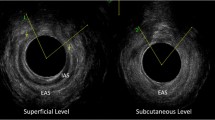Abstract
Introduction and hypothesis
Obstetric anal sphincter injuries (OASIS) complicate around 1–2% of deliveries in low- and middle-income countries. Asians are twice more likely to suffer this complication. The 3c and 4th-degree perineal tears that involve the internal anal sphincter muscle and the anal mucosa have been reported to have a poorer outcome and higher risk of recurrence compared to less severe tears.
Methodology
A retrospective 10-year analysis of third- and fourth-degree perineal tears in a tertiary centre was conducted. The maternal, neonatal factors and their respective outcomes after the repair of an OASI were examined and compared between minor (3a and 3b perineal tears) and major anal sphincter tears (3c and 4th-degree perineal tears).
Results
Five hundred twenty patients with OASIS were included into the study. Birthweight ≥ 3.5 kg was significantly associated with having a major anal sphincter tear in this study population, OR 1.91 (95% CI 1.21–3.02), p = 0.006. There was no significant difference in having faecal or flatus incontinence after the repair; however, major anal sphincter tears appeared to be more complicated to repair compared to minor anal sphincter tears, requiring involvement of the consultant, p < 0.001.
Conclusion
Neonatal birthweight ≥ 3.5 kg was the most significant factor in predicting the severity of OASIS in this study population. After appropriate repair, the rates of reported complications appeared similar between the two groups. However, significantly more expertise and resources were required for the repair of higher degree OASIS.
Similar content being viewed by others

Abbreviations
- OASIS:
-
Obstetric anal sphincter injuries
- OASI:
-
Obstetric anal sphincter injury
- OT:
-
Operating theatre
- SD:
-
Standard deviation
- PPH:
-
Postpartum haemorrhage
- BMI:
-
Body mass index
- CI:
-
Confidence interval
- NMRR:
-
National Medical Research Register
- ID:
-
Identification
References
Aguiar M, Farley A, Hope L, et al. Birth- related perineal trauma in low- and middle-income countries: A systematic review and meta-analysis. Matern. Child Health J. 2019;23:1048–70.
The Management of Third- and Fourth-Degree Perineal Tears. Green-top Guideline No. 29. June 2015. Royal College of Obstetricians & Gynaecologists.
Bates LJ, Melon J, Turner R, et al. Prospective comparison of obstetric anal sphincter injury incidence between an Asian and Western hospital. Int Urogynecol J. 2019;30:429–37.
Tung CW, Cheon WC, Tong WM, Leung HY. Incidence and risk factors of obstetric anal sphincter injuries after various modes of vaginal deliveries in Chinese women. Chin Med J. 2015;128(18):2420–5.
Gundabattula SR, Surampudi K. Risk factors for obstetric anal sphincter injuries (OASI) at a tertiary centre in south India. Int Urogynecol J. 2018;29:391–6.
Sultan AH, Monga A, Lee J, et al. An International Urogynecological Association (IUGA)/International Continence Society (ICS) joint report on the terminology for female anorectal dysfunction. Neurourol Urodyn. 2017;36(1):10–34.
Pihl S, Blomberg M, Uustal E. Internal anal sphincter injury in the immediate postpartum period; Prevalence, risk factors and diagnostic methods in the Swedish perineal laceration registry. Our J Obstet Gynecol Reprod Biol Feb. 2020;245:1–6.
Roos AM, Thakar R, Sultan AH. Outcome of primary repair of obstetric anal sphincter injuries (OASIS): does the grade of tear matter? Ultrasound Obstet Gynecol. 2010;36:368–74.
Evans E, Falivene C, Briffa K, et al. What is the total impact of an obstetric anal sphincter injury? An Australian retrospective study. Int Urogynecol J. 2020;31:557–66.
Ahmed WAS, Kick EA, Farhan RI, et al. Female sexual function following different degrees of perineal tears. Int Urogynecol J Jun. 2017;28(6):917–21.
Kulkarni J, Aj P, Musande B, et al. Management of fourth degree obstetric perineal tear without colostomy using non-stimulated gracilis-our experience over eleven years. Indian J Plast Surg Jan-Apr. 2016;49(1):26–34.
Brincat C, Crosby E, Mcleod A, et al. Experiences during the first four years of a postpartum perineal clinic in the USA. Int J Gynecol and Obs. 2015;128:68–71.
D’Souza JC, Monga A, Tincello DG, et al. Maternal outcomes in subsequent delivery after previous obstetric anal sphincter injury (OASI): a multi-centre retrospective cohort study. Int Urogynecol J. 2020;31:627–33.
Gachon B, Menard CF, Pierre F, et al. Does the implementation of a restrictive episiotomy policy for operative deliveries increase the risk of obstetric anal sphincter injury? Arch Gynecol Obstet Jul. 2019;300(1):87–94.
Verghese TS, Champaneria R, Kapoor DS, et al. Obstetric anal sphincter injuries after episiotomy: systematic review and meta- analysis. Int Urogynecol J. Oct. 2016;27(10):1459–67.
Poon WB, Fook- Chong SMC, Ler GYL, et al. Creation and validation of the Singapore birth nomograms for birth weight, length and head circumference based on a 12-year birth cohort. Ann Acad Med Singapore. 2014;43:295–304.
Wong Wh, Rathimalar K, Muralitharan G. OASIS: A 3-year Retrospective Review In Ampang Hospital. Abstract publication of a Poster Presentation. Med J Malaysia. 2017;72(Supplement 3):10.
Murphy DJ, Strachan BK, Bahl R. on behalf of the Royal College of Obstetricians Gynaecologists. Assisted Vaginal Birth. BJOG. 2020;127:e70–e112.
Acknowledgements
The authors would like to thank all the interns, residents and nursing staffs for their help during the data collection process. We would like to thank the Director General of Health Malaysia for his permission to publish this article.
Author information
Authors and Affiliations
Contributions
TAN ACC: Protocol/project development, Data collection or management, Data Analysis, Manuscript writing/editing
Mohd Yusoff F: Protocol/project development, management Data analysis, Manuscript editing
Salleh M FA: Project development, Data collection, Manuscript editing
Chua AC: Protocol/project development, Management data analysis, Manuscript writing/editing
Corresponding author
Ethics declarations
Conflict of interest
None to be declared
Additional information
Publisher’s note
Springer Nature remains neutral with regard to jurisdictional claims in published maps and institutional affiliations.
Rights and permissions
About this article
Cite this article
Tan, A.C.C., Mohd Yusoff, F.B., Salleh, M.F.A.B. et al. What are the factors that may predict the severity of perineal tears in obstetric anal sphincter injuries and how are their outcomes? A 10-year retrospective analysis in a Southeast Asian population. Int Urogynecol J 33, 1667–1674 (2022). https://doi.org/10.1007/s00192-022-05164-y
Received:
Accepted:
Published:
Issue Date:
DOI: https://doi.org/10.1007/s00192-022-05164-y


